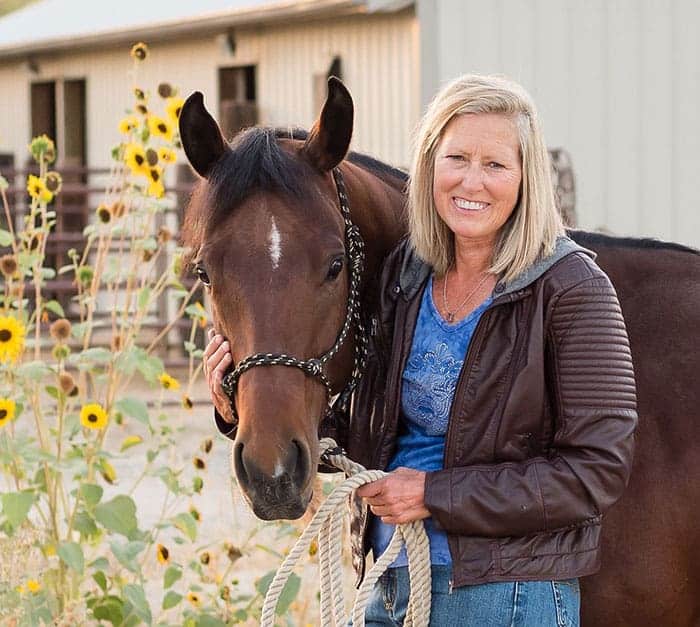The Benefits of Grazing Horses at Night

Grazing your horses at night can be a tool to beat the heat, bugs, and weight gain.
Night turnout is a much-welcomed relief from the pestering flies and grueling heat of hot summer days. It’s also a great way to have horses on grass for extended periods while reducing the risk of them becoming overweight.
“Night grazing is a tool for managing horses on pasture to keep horses from becoming overweight,” said Katy Watts, plant biologist, former agricultural researcher, and owner of Safergrass.org, a business focused on managing sugars in grasses. “The natural cycle of pasture plants is such that when the sun goes down the plants stop photosynthesizing and producing sugar. As the night progresses, (the plants) use the sugars (they produced during the day) to grow.”
A metabolically normal horse—one not insulin resistant, Cushingoid (has pituitary pars intermedia dysfunction, or PPID), or laminitic—that can handle eight hours of pasture during the day but is starting to gain too much weight will benefit from nighttime turnout.
“I am a firm believer that there are a lot of good things in pasture that you just can’t get in hay,” said Watts. “And I have always been an advocate of allowing horses as much access to pasture as possible as long as they don’t get fat. It’s not healthy to be fat.”
These guidelines are for North American summers where sugars in the plant’s diurnal (daily) cycle are lowest at 3 a.m. and start rising again after sunrise. At extreme latitudes, as would be the case in places like Scotland or Alaska, the diurnal rhythm is compressed, and long daylight hours means plants are producing sugars well into the night.
Another low-sugar alternative to night grazing is turning horses out on pasture in the early morning, around 6 a.m., and bringing them in around 10 a.m. when plant production of sugar becomes high again. “This is especially useful if you are a morning person,” said Watts. “It all depends on when people go to work and their sleep cycle. If you are an early riser, it might work better getting up early and just putting them out for a few hours and then again (putting them out) in the evening.”
Once overnight temperatures drop below 40 degrees, be wary of night grazing. “When we get a hard frost that (summer growing) cycle is over, and sugar levels will remain high through the night,” said Watts. The end of summer signals a hard stop to night grazing for most horses, especially for those with metabolic conditions such as PPID or laminitis.
Because PPID horses often have insulin regulation issues, reducing sugar in these individuals’ diets is usually beneficial. Along with your veterinarian’s advice, limited early morning grazing might be the safest choice for them. It could be a way to allow them a long turnout time without compromising their safety and to keep them from needing a drylot.
Just be “observant and flexible,” Watts said. “Are your horses getting fatter or thinner?” Adjust your grazing schedule accordingly.
Tips for Grazing Horses at Night
If you have horses that might benefit from night grazing, check out these do’s and don’ts:
Do’s:
- Secure perimeter fencing, and be sure all gates are latched properly.
- Have plenty of fresh water available for horses in their grazing area. Studies with other livestock show animals graze more and are less likely to test fencing when they have both food and water.
- If mosquitoes or nighttime insects are a problem, use fly repellent before putting horses out.
- Implement a rotational grazing program to avoid overgrazing. The greatest amount of sugar in short grass plants is in the bottom 3 inches, or the seedhead in tall grass. For more help designing a rotational grazing system for your property, contact your local conservation district, extension office, or the Natural Resources Conservation Service.
- Treat each horse as an individual. Just like with people, one horse’s dietary needs might not be the same as another’s.
- Learn what your horse’s healthy weight should be. Seek help from a veterinarian, equine nutritionist, forage agronomist, and/or professional experienced in this area, especially if you have an at-risk individual metabolically (PPID, laminitis-prone, etc.). Make any changes in diet gradually to give the horse’s gut time to adjust.
Don’ts:
- Don’t overgraze pastures. The greatest amount of sugar in a grass plant is concentrated in the bottom 3 inches or the seedheads. Overgrazing kills grass and encourages weeds that might be higher in sugar than the grass.
- Don’t graze during cool weather (40 degrees and lower), especially if there is frost. Pasture plants store carbohydrates at very high levels during these times, making them extremely high in sugars and dangerous to graze.
- Don’t be fooled by the late summer brown grass—brown, yellow, or dried grasses can be very high in sugars. Pastures are healthiest for horses (lowest in sugars) during the active growing season when plants are green and not stressed. Therefore, graze horses during the active growing seasons (spring and summer), and limit grazing of dried-out pastures.
Take-Home Message
If your horse is metabolic or at risk, research this area further, and seek professional help. Talk with your veterinarian about specific feeding and grazing recommendations for your horse.
“We all have to be creative,” said Watts. “We need to do what fits best for our needs, our horses’ needs, and the best use of the pasture.”

Written by:
Alayne Blickle
Related Articles
Stay on top of the most recent Horse Health news with











